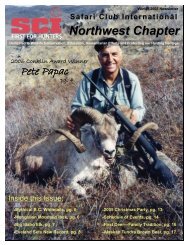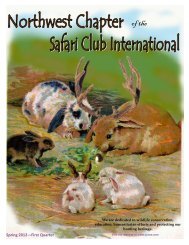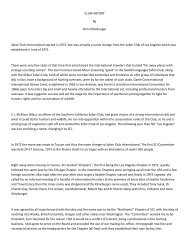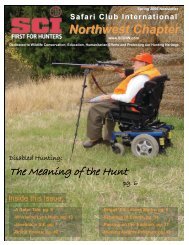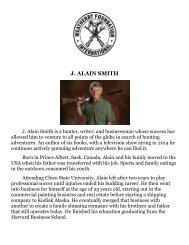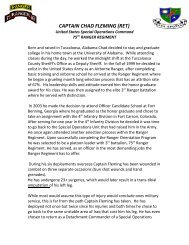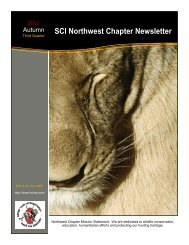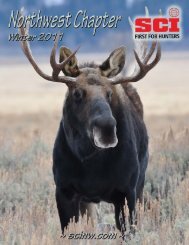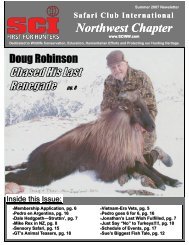The Northwest Chapter Safari Club International
The Northwest Chapter Safari Club International
The Northwest Chapter Safari Club International
Create successful ePaper yourself
Turn your PDF publications into a flip-book with our unique Google optimized e-Paper software.
28<br />
should scout with your binos, but also thinking this was almost<br />
certainly a big bull, I put my rifle scope on the animal and con‐<br />
firmed it was in fact a nice bull – straight across the park on a hill‐<br />
side, feeding. I had seen the white tips of his antlers moving as he<br />
moved his head. So for about three or four minutes I just<br />
watched. He was incredible. Straight out of an outdoor magazine<br />
– a mature bull, feeding in plain view 250 yards away from me, and<br />
he had no idea I was there. After watching him, I started to get<br />
nervous thinking – what if he spooked and I never took a shot? So<br />
I made up my mind to shoot – and then the rifle went<br />
off. <strong>The</strong> .308, shooting a 180 grain Winchester fail‐safe, was at the<br />
limit of its effective range on game of this size – but I knew that it<br />
was all about shot placement. After the shot, I looked up to see<br />
what had happened. No elk, lots of quiet. Had I missed? Did I hit<br />
the elk? Anyway, it was time to wait. So I waited about 15 min‐<br />
utes (I know, they say 30 minutes – but I was anxious) – and then<br />
headed over to see what I could find.<br />
I got there and saw nothing. My first reaction was – damn, I<br />
missed the elk of a lifetime. Wow, and I considered myself a good<br />
shot. I looked around and didn’t see anything. As I started to<br />
widen my search, I saw him. <strong>The</strong>re he was, dead, about 30 yards<br />
from where he was standing. When I shot him, he had been facing<br />
me at a slight angle, and I had hit him squarely between the shoul‐<br />
ders – and as I cleaned the elk, I found the bullet lodged in his rear<br />
hip. It had traveled the entire length of his body – taking out his<br />
lungs, heart, and other organs. I was ecstatic…public land, hunting<br />
by myself, and a mature 6x5 on the ground. It took horses, horse<br />
trailers, and two friends to get the elk out of that spot – but at<br />
about midnight we were finally home and ready to begin the rest<br />
of our hunt.<br />
<strong>The</strong> last seven days of our hunt weren’t nearly as productive as<br />
the first two. We didn’t see any more bulls – and it wasn’t for a<br />
lack of trying. We hiked deep into the Pintler Wilderness and<br />
through many of the other areas that we thought would hold<br />
elk. In every case, nothing. We ended up with two elk for three<br />
hunters – and those were taken in the first two days of our nine<br />
day hunt.<br />
<strong>The</strong> second part of my 2011 Montana experience took place in<br />
<strong>Northwest</strong> Montana, near the town of Seeley Lake in the Swan<br />
Valley. My wife’s family has been a part of the Swan Valley for<br />
more than eighty years – with her great grandfather working for<br />
the US Forest Service in what is now the Bob Marshall Wilderness,<br />
and family members for more than eighty years hunting in the<br />
valley and surrounding hills. Three years ago, I had drawn a Mon‐<br />
tana deer tag and, along with a friend, drove to Seeley Lake deter‐<br />
mined to get a buck. After spending nearly a week in the moun‐<br />
tains, we came home empty‐handed – having only taken a doe. It<br />
was frustrating, for I knew that big bucks definitely lived in the<br />
area. <strong>The</strong> challenge was just finding them. So this year, instead of<br />
trying to do it by myself again, I decided to hire a local outfitter to<br />
guide me for the five days I’d be there. I thought that it would<br />
probably be the best way to learn how to hunt the valley.<br />
I timed the hunt to correspond with the deer rut, which meant<br />
hunting in mid‐November. <strong>The</strong> drive over to Seeley Lake from<br />
www.scinw.com<br />
Seattle saw the weather get worse and worse – and by the time I<br />
got there, I saw a foot of snow on the ground and temperatures<br />
hovering around ten degrees. This was going to be a cold hunt –<br />
the Montana mountains in what turned out to be one of the earli‐<br />
est winters in more than a decade. <strong>The</strong> good news, though, was<br />
that the snow pushed the deer down from the hills and concen‐<br />
trated them in the valley bottom and winter range areas – making<br />
finding them much easier.<br />
Together with the guide, we hunted hard for all five days. We<br />
used both spot‐stalk and calling to find the deer – and every day<br />
saw mature bucks. <strong>The</strong> first real shooting opportunity I had on the<br />
second day as we were walking through a regenerated clear‐cut. I<br />
saw two big‐bodied bucks walking away from us in the woods at<br />
about 200 yards. We froze – and began to call the deer using a<br />
grunt. We set up behind a stump, and a few moments later a big‐<br />
bodied 5x4 came out of the tree line and stood there, broadside,<br />
head turned at us. With my crosshairs on the deer, I asked the<br />
guide…”take him?” “Your call…but I would recommend against<br />
it. You can’t shoot the big ones if you shoot the small ones.” So I<br />
was staring at a nice buck, at 60 yards, in my crosshairs –and the<br />
guide wanted me to not shoot. Wow, this was going to be a great<br />
trip…so I waited.<br />
Every day of the hunt showed similar results. Lots of deer – and<br />
every day one look at a big deer. On the third day we moved to a<br />
new area – a hillside that was pretty brushy, in an area that had<br />
been previously thinned, adjacent to a thick older growth for‐<br />
est. <strong>The</strong> guide indicated that he had seen a bigger buck in here in<br />
previous years, and wanted to take a look. As we walked in the<br />
first day, we saw a group of does, downhill at about 150 yards in<br />
the brush. As we watched the does moving, I got my first glimpse<br />
of the biggest deer I’d ever seen. I saw him chasing a doe and then<br />
stood still for about a minute, as I got myself into position to<br />
shoot. Unfortunately, when I got my scope back on the buck, all I<br />
saw was his rump…separated from the tips of his antlers by a large<br />
tree. Not being willing to take the unethical shot, through the<br />
brush, at his body – I let him go. <strong>The</strong> rest of that day I retreated to<br />
a ground blind on the hillside, watched, and waited. I saw a num‐<br />
ber of does as well as some smaller bucks, but never the big guy.<br />
We hunted the same area the next day, and again I saw (and<br />
heard grunt) the big buck. But this time he showed himself right at<br />
sunset – and the only shot was again unethical, so I passed.<br />
<strong>The</strong> last day of the hunt came and I had a good feeling. As we<br />
walked back into the same area, we noticed some new deer prints<br />
in the snow. Maybe there was another big buck in the area? We<br />
walked In and took up a position on the same hillside, overlooking<br />
the brushy clearing where we’d seen activity before. Again, more<br />
does and bucks – including a 4x4 that was awfully tempting on my<br />
last day. But I passed, and waited. It was stormy and cold – and<br />
the deer were moving unlike anything we’d seen before. We de‐<br />
cided to grunt and rattle to see if we could get the big buck’s at‐<br />
tention – and sure enough, after about 15 minutes the guide



